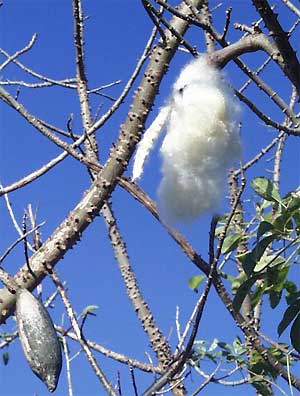Excerpts from Jim Conrad's
Naturalist Newsletter
from the January 23, 2005
BUZZING IN THE KITCHEN CEIBA
Each morning this week just when it grew light enough to see things, something magical has been happening. Up in the big Ceiba tree (SAY-bah), CEIBA PENTANDRA, near the thatch-roofed kitchen, there's been a deep buzzing. "Deep buzzing" is too anemic a word to describe that sound. It's a buzzing heard more in the chest than the ears. The dogs sit up, cock their heads and look around, their faces asking if they need to start barking.
It's honeybees, thousands of them, and I'm not really sure why their buzzing is so powerful so early. Maybe it's because at dawn the winds haven't begun blowing yet, or maybe it's because this big Ceiba, so amazingly full of silver-dollar-size, pinkish blossoms, promises such abundant nectar and pollen that a hive dreams all night of what's to come at dawn and, like a child on Christmas morning, just can't wait.
If tropical America has a mystical tree, it must be the Ceiba. The ancient Maya conceived of a great Ceiba at the Earth's center connecting the terrestrial world to the spirit-world. Even slash-and-burn farmers often spare Ceibas as they cut all the forest around them. In climates with much more rain than ours, Ceibas grow to enormous sizes, producing broad, spreading crowns. Where soil is mushy the trunks develope flaring buttresses like rocket fins. Every tropical naturalist has a picture of himself or herself standing among a giant Ceiba's butresses. You can read about Ceibas and see some pictures at www.ceiba.org/ceiba.htm.
Because we're deep into the dry season, and Ceibas are one species dropping their leaves when the dry season begins, our Ceibas now look like huge Flowering-Peach trees -- naked limbs loaded with gorgeous pink flowers. And bees are only part of the wildlife visiting them. Lots of beetles and bugs buzz around the flowers, and many kinds of birds come for the nectar or the insects associated with the nectar, depending on the bird species.
Deep in the dry season there's not much blossoming now, so the Ceibas' enormous bouquet-offerings must be life- saving for many, a kind of absolutely-necessary link in the chain of blossomings that throughout the year sustain life. What a gift these Ceibas are to us all.
As early, orangish, dawn sunlight slants in from the east illuminating the giant tree's pink blossoms and the blue sky arches over all, how pretty among the pink-bouquet limbs are the orange and black orioles, and the blue and black jays... And all this buzzing, the buzzing, the deep, meaningful, happy-sounding buzzing...
MORE FROM THE JANUARY 28, 2006 NEWSLETTER:
KAPOK
Several collections of books cluster in this and that corner at the hacienda. Many books were left by the previous owner and many more have been ruined by flooding from one or more hurricanes and thrown away. What remains is almost like a random collection in a Salvation Army used-book bin, everything from science fiction to classic novels and technical works.
Right now I have open next to me the "Hand Book of Tropical Plants" by HF Macmillan, published in New Delhi, India. The book's pages are yellowed and smell as you'd expect them to after moldering for many years in heavy heat and high humidity. It was written with a focus on tropical gardening in India and Ceylon, back in the days when English functionaries and plantation managers maintained palatial estates there. Its "Proposed Plan of a Garden" includes a garden house with a spacious verandah and a drawing room, with a building apart for the kitchen and the "boys" to live in, and a tennis court.
I have this book out because right now a young Ceiba tree next the hacienda's entrance gate is bearing on its stout, leafless branches several cantaloupe-sized wads of what look like cotton. Below, you can see one of those wads, which is the Ceiba's fruit splitting open to release very hairy seeds, with an immature, still unopened fruit at the lower left.

Macmillan's book was written back when Ceiba "cotton" was regarded as having value. He wrote:
"Until lately, kapok fibre has been used chiefly for stuffing pillows, cushions, etc., and during the war for life-saving waistcoats and similar articles. Recently, it has been employed for mixing with other fine fibres for textile purposes."
The war Macmillan mentioned was the First World War, and his kapok was the fuzz on our Ceiba tree. Our Ceiba (pronounced SAY-bah) tree is CEIBA PENTANDRA, a member of the tropical Bombax Family.
Ceibas are native to the American tropics and when they grow old where there's plenty of rain they can be gigantic, growing 100 feet and more high, with immense horizontal, far- reaching branches, and wide-flung, thin buttresses extending from the trunks for 30 feet or more, like fins on a rocket. In rainier country the Ceiba's spreading branches bear airborne gardens of orchids, bromeliads, ferns, mosses, peperomias and the like. If any tree possesses a majestic, even spiritual, presence, it's the Ceiba.
But, our little Ceiba next to the gate exhibits none of that majesty, and only a handful of its pods are releasing kapok. Actually the tree makes a rather awkward- looking presence, its naked, stubby branches bristling with broad-based spines, and the tree hardly rising above the surrounding scrub.
But, I have seen enough grand old Ceibas farther south to know to tip my hat to this little tree whenever I pass him by.